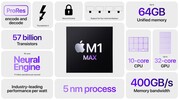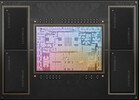AMD Ryzen 7 5700X vs Apple M1 Max vs Apple M2 Pro 10-Core
AMD Ryzen 7 5700X
► remove from comparison
The AMD Ryzen 7 5700X is a desktop processor with 8 cores and simultaneous multithreading (SMT), which means it can process 16 threads simultaneously. In April 2022, AMD presented the Ryzen 7 5700X, a new 8-core processor that is very similar to the AMD Ryzen 7 5800X. However, due to the lower TDP, there are no restrictions on the clock frequency. Nevertheless, the AMD Ryzen 7 5700X reaches up to 4.6 GHz in boost, which is only 100 MHz less than the AMD Ryzen 7 5800X. However, the base clock drops significantly to 3.4 GHz.
The performance of the AMD Ryzen 7 5700X is consistently excellent in all applications. The native 8-core can really show off its strengths, especially in multi-threaded applications, although the single-core performance has also been significantly improved compared to the older Zen 2 architecture.
The internal structure of the processor is similar to the AMD Ryzen 7 5800X. The CCX modules are also connected to each other via the I/O die, which we already know from Zen2. However, according to AMD, the Infinity Fabric should now achieve clock rates of up to 2 GHz, which in turn enables a RAM clock rate of 4,000 MHz without any loss of performance.
In terms of manufacturing processes, AMD also relies on TSCM for the 7nm production of the CPU cores in the Vermeer processors, although the I/O die is still supplied in 12 nm by Globalfoundries.
The AMD Ryzen 7 5700X is impressive in gaming thanks to the significantly improved IPC compared to Zen2. In terms of power consumption, the AMD Ryzen 7 5700X impresses with its low TDP of just 65 watts. This means that the processor can also be operated with a compact air cooler without any problems. The AMD Ryzen 7 5800X is operated with a TDP of 105 watts.
Apple M1 Max
► remove from comparison
The Apple M1 Max is a System on a Chip (SoC) from Apple that is found in the late 2021 MacBook Pro 14 and 16-inch models. It offers all 10 cores available in the chip divided in eight performance cores (P-cores with 600 - 3220 MHz) and two power-efficiency cores (E-cores with 600 - 2064 MHz). There is no Turbo Boost for single cores or short burst periods. The cores are similar to the cores in the Apple M1.
The big cores (codename Firestorm) offer 192 KB instruction cache, 128 KB data cache, and 24 MB shared L2 cache (up from 12 MB in the M1). The four efficiency cores (codename Icestorm) are a lot smaller and offer only 128 KB instruction cache, 64 KB data cache, and 4 MB shared cache. CPU and GPU can both use the 48 MB SLC (System Level Cache). The efficiency cores (E cluster) clock with 600 - 2064 MHz, the performance cores (P cluster) with 600 - 3228 MHz.
The unified memory (32 or 64 GB LPDDR5-6400) next to the chip is connected by a 512 bit memory controller (200 GB/s bandwidth) and can be used by the GPU and CPU. This is the main difference to the M1 Pro and the CPU performance is quite similar.
The biggest difference to the M1 Pro is the bigger integrated GPU with 24 or 32 cores (up from 16).
Furthermore, the SoC integrates a fast 16 core neural engine, a secure enclave (e.g., for encryption), a unified memory architecture, Thunderbolt 4 controller, an ISP, and media de- and encoders (including two ProRes engines).
The M1 Pro is manufactured in 5 nm at TSMC and integrates 57 billion transistors. The peak power consumption of the chip was advertised around 30W for CPU intensive tasks.
Apple M2 Pro 10-Core
► remove from comparison
The Apple M2 Pro 10-Core is a System on a Chip (SoC) from Apple that is found in the early 2023 MacBook Pro 14 and Mac Mini entry level models. It offers 10 of the 12 cores available in the chip divided in six performance cores (P-cores) and four power-efficiency cores (E-cores). The E-cores clock with up to 3.4 GHz, the P-Cores up to 3.7 GHz (mostly 3.3 GHz in multi-threaded workloads and 3.4 GHz in single threaded).
The big cores (codename Avalanche) offer 192 KB instruction cache, 128 KB data cache, and 36 MB shared L2 cache (up from 24 MB in the M1 Pro). The four efficiency cores (codename Blizzard) are a lot smaller and offer only 128 KB instruction cache, 64 KB data cache, and 4 MB shared cache. CPU and GPU can both use the 24 MB SLC (System Level Cache).
The unified memory (16 or 32 GB LPDDR5-6400) next to the chip is connected by a 256 Bit memory controller (200 GB/s bandwidth) and can be used by the GPU and CPU.
The performance of the M2 Pro 10-Core should be similar to the old M1 Pro with all 10 cores. The multi-threaded performance should be slower, as the M2 10-core has two p-cores less (and 2 e-cores more) but the single-threaded performance should be better due to the faster clock speed and architectural improvements. The old M1 Pro 8-core should be noticeably slower.
The integrated graphics card in the M1 Pro 10-core offers all 16 of the 19 cores.
Furthermore, the SoC integrates a fast 16 core neural engine (faster than M1 Pro), a secure enclave (e.g., for encryption), a unified memory architecture, Thunderbolt 4 controller, an ISP, and media de- and encoders (including ProRes).
The M2 Pro is manufactured in 5 nm at TSMC (second generation) and integrates 40 billion transistors.
| Model | AMD Ryzen 7 5700X | Apple M1 Max | Apple M2 Pro 10-Core | ||||||||||||||||||||||||||||||||||||||||||||||||
| Codename | Vermeer (Zen 3) | ||||||||||||||||||||||||||||||||||||||||||||||||||
| Series | AMD Vermeer (Ryzen 5000) | Apple M1 | Apple M2 | ||||||||||||||||||||||||||||||||||||||||||||||||
| Series: M2 |
|
|
| ||||||||||||||||||||||||||||||||||||||||||||||||
| Clock | 3400 - 4600 MHz | 2060 - 3220 MHz | 2424 - 3696 MHz | ||||||||||||||||||||||||||||||||||||||||||||||||
| L1 Cache | 512 KB | 2.9 MB | 7.3 MB | ||||||||||||||||||||||||||||||||||||||||||||||||
| L2 Cache | 4 MB | 28 MB | 36 MB | ||||||||||||||||||||||||||||||||||||||||||||||||
| L3 Cache | 32 MB | 48 MB | 24 MB | ||||||||||||||||||||||||||||||||||||||||||||||||
| Cores / Threads | 8 / 16 | 10 / 10 | 10 / 10 | ||||||||||||||||||||||||||||||||||||||||||||||||
| TDP | 65 Watt | ||||||||||||||||||||||||||||||||||||||||||||||||||
| Technology | 7 nm | 5 nm | 5 nm | ||||||||||||||||||||||||||||||||||||||||||||||||
| Die Size | 2 x 74 sq. mm; I/O = 125 sq. mm mm2 | ||||||||||||||||||||||||||||||||||||||||||||||||||
| max. Temp. | 90 °C | ||||||||||||||||||||||||||||||||||||||||||||||||||
| Socket | 1331 | ||||||||||||||||||||||||||||||||||||||||||||||||||
| Features | MMX(+), SSE, SSE2, SSE3, SSSE3, SSE4.1, SSE4.2, SSE4A, x86-64, AMD-V, AES, AVX, AVX2, FMA3, SHA, Precision Boost 2 | ARMv8 Instruction Set | ARMv8 Instruction Set | ||||||||||||||||||||||||||||||||||||||||||||||||
| Architecture | x86 | ARM | ARM | ||||||||||||||||||||||||||||||||||||||||||||||||
| $299 U.S. | |||||||||||||||||||||||||||||||||||||||||||||||||||
| Announced | |||||||||||||||||||||||||||||||||||||||||||||||||||
| Manufacturer | www.amd.com | ||||||||||||||||||||||||||||||||||||||||||||||||||
| Transistors | 57000 Million | 40000 Million | |||||||||||||||||||||||||||||||||||||||||||||||||
| iGPU | Apple M1 Max 32-Core GPU | Apple M2 Pro 16-Core GPU | |||||||||||||||||||||||||||||||||||||||||||||||||
| Chip AI | 11 TOPS INT8 | 15.8 TOPS INT8 |
Benchmarks
Average Benchmarks AMD Ryzen 7 5700X → 100% n=16
Average Benchmarks Apple M1 Max → 105% n=16
Average Benchmarks Apple M2 Pro 10-Core → 106% n=16
* Smaller numbers mean a higher performance
1 This benchmark is not used for the average calculation













